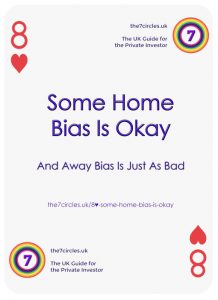8♥ – Some Home Bias Is Okay
Some Home Bias Is Okay - And Away Bias Is Just As Bad
This post is part of the MoneyDeck series, a pack of 52 playing cards that describe 52 “golden rules” for Private Investors in the UK.
Some Home Bias Is Okay – And Away Bias Is Just As Bad
It’s become fashionable in recent years to say that investors need to “own the world” – they need to passively track all of the financial assets available.
I’m not completely sold on the idea.
- I think that the idea of an investable universe is useful, as it puts to bed the idea that buying a single Vanguard index fund makes you a good passive investor.
In fact, we are all active investors and I’m far from sure that being 100% passive is a good idea.
Whether you should be passive or active depends on your goals, and the markets that you need to access.
- The more developed the market, the more likely you are to plump for a passive fund (an ETF or an OEIC) than an active fund (an investment trust).
- But in your home market – particularly in a liquid, internationally-focused market like the UK – you might prefer to hold stocks directly, either in a buy and hold strategy, or by active trading.
The same logic applies to the concept of avoiding home bias.
Home bias is the tendency of investors to put a large proportion of their money into domestic equities, despite the benefits of diversifying into foreign stocks.
- It was first documented by French and Poterba (1991) and then Tesar and Werner (1995).
- Coval and Moskowitz (1999) then showed that home bias worked within a country, too – US investment managers prefer firms with local HQs.
The historical basis for home bias was the extra difficulty involved in investing abroad (legal restrictions, extra transaction costs).
- These difficulties have reduced over time, and products like investment trusts, OEICs and ETFs have made investing abroad easier.
An alternative explanation is that domestic equities are seen as a hedge against domestic inflation, although over shorter time-frames this hedge is somewhat imperfect.
People are also much more familiar with the companies in their home market and tend to trust them more (see them as safer).
- They are also more likely to be optimistic about the prospects for the domestic market, and to be pessimistic or indifferent about foreign markets.
It’s a lot like supporting the England football team, really.
So what are the reasons for sticking with your home team?
Well, currency for one.
- Going international exposes you to currency risk, (( Unless you pay extra for hedged exposure – which also increases correlations and therefore reduces the diversification benefits )) which although it should even out over the long term, can be awkward in the short term.
This is a particular issue for those who intend to retire in their own country, and an even bigger problem for those whose international exposure is focused in a single currency (the dollar).
- These “away bias” folks are vulnerable to an adverse move in the sterling / dollar rate (( The opposite to what we have just witnessed following Brexit )) just as they hit retirement.
There are also informational issues.
- We best understand the companies, governments and legal systems closest to us.
- In terms of companies, this is particularly true of smaller stocks.
- Most people – particularly those in developed markets – feel that corporate governance (reporting, transparency, shareholder rights) is stronger in mature (home) markets.
These informational advantages translate into cost advantages.
- It is usually cheaper to trade in local stocks, and there are no FX charges involved.
- Funds investing in your home market will usually be cheaper than those investing abroad.
- And in some countries, there are tax penalties on foreign holdings.
So how much home bias is there?
Figures aren’t easy to come by, but back in 2001, 72% of equities owned by UK investors were from the UK.
- By 2012 this had fallen to 47%, which is a lot better.
Defaqto reported in 2016 that managed portfolios have an average 50% allocation to the UK (across both equities and fixed income).
- Their “optimised risk/return benchmarks” had only 20% allocation to the UK.
In France and Germany, 65% of equity holdings were domestic in 2012.
Even in tiny economies like Sweden (around 1% of global equity market cap) investors have historically bought almost entirely domestic equities.
Probably the worst country for home bias is the US.
- Vanguard reported in 2014 that only 27% of US equity holdings were foreign.
The price paid for home bias varies a lot depending on where you call home.
There is evidence (Berrill and Kearney, 2010) that by investing in internationalised firms listed on the home exchanges, investors will still reap the benefits of diversification.
US investors have the best excuse for staying put.
- Their large stocks are multinationals, with earnings from around the globe, and the US markets make up more than 50% of the global stock market capitalisation.
The large, international UK market is probably second best, but it’s a relatively poor second, with only around 7% of the global market cap.
- And you need to watch out for the FTSE-100 concentration in resources, by diversifying into smaller UK stocks as well.
More inward-looking markets like Japan, and more concentrated ones like China (mostly financials) come further down this scale.
Where you really take the hit from home bias is if you live in a small economy dominated by a single sector.
- Resource-rich Canada and Australia fit the bill here.
Vanguard regularly publishes studies in this area which support the claims above.
- Their 2012 report looked at the US, UK, Australia and Canada.
- It plotted the returns against volatility (standard deviation of returns) for portfolios ranging from 100% domestic to 100% international.
Their conclusions were:
U.S. investors may have some justification for marginal home bias, but investors in Australia and Canada might consider increasing their allocations to foreign securities. The results for U.K. investors are mixed, with less overall concentration in domestic securities but still room to diversify.
The sweets spots for the portfolios were:
- US – 80% domestic
- UK – 65% domestic
- Australia – 50% domestic
- Canada – 35% domestic
The core concept in avoiding home bias – that you need to diversify internationally – is hard to disagree with.
- It’s not sensible to hold all your assets in a single country.
- Investing in foreign stocks reduces the systematic risk in your portfolio because the foreign stocks are less likely to be affected by the forces acting on the domestic market.
Diversification is a free lunch, but only up to a point.
- The law of diminishing returns applies, as it does to avoiding home bias.
If you go too far, you run into the opposite problem – what I’ve called above the “away bias”.
- Given the structure of international markets, away bias takes the form of overexposure to the US – to its tech stocks, and to the dollar.
Despite the recent outperformance of US stocks, this can be just as bad and possibly worse.
So what’s the answer?
Well, it’s definitely a good idea to have half of your stock portfolio invested abroad.
- This should happen naturally, through your asset allocation process.
- You need to be diversified across geographies and across company sizes.
- There’s no need to think of it as a “home bias” fix.
That doesn’t mean you should just buy an ex-UK global tracker that will put 60% of the money into the US.
- That’s just replacing the biases of the UK market with those of the US market.
- Not to mention the large-cap bias that is inevitable in such a fund.
- And the fact that it will also put 93% of your money outside the UK, increasing your dependency on a weak pound.
Divide your portion to seven or even to eight, for you do not know what misfortune may occur on the earth – Ecclesiastes 11:2
It’s better to make roughly equal bets on the foreign markets that you feel are distinctive.
- For me, that’s the US, Europe, Japan, APAC, China and Emerging Markets.
- I would double weight the US and Europe and single-weight the other four.
Such a portfolio would have performed well during 2016, when the post-Brexit crash in sterling pushed up the price of foreign stocks, and boosted the FTSE-100, who largest companies have a lot of foreign earnings.
You could go more international if you preferred, but in my view it’s more work and higher costs for diminishing returns.
Bonds are less troublesome, unless you have a home government that you don’t trust.
With property, you’re almost bound to have a home bias.
- That’s not a problem if you intend to retire at home.
So remember: Some Home Bias Is Okay – And Away Bias Is Just As Bad
Until next time.

















